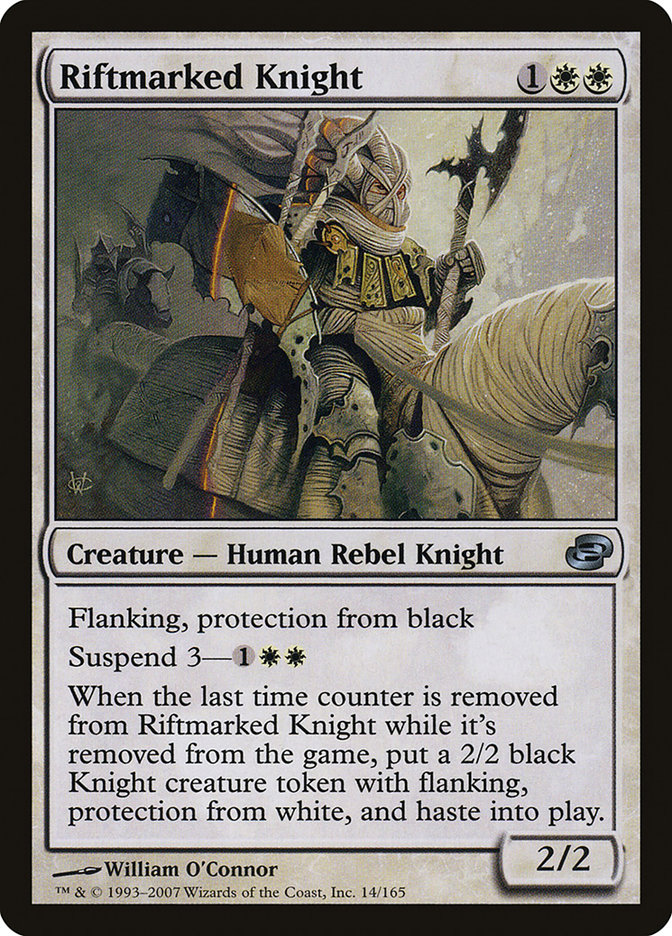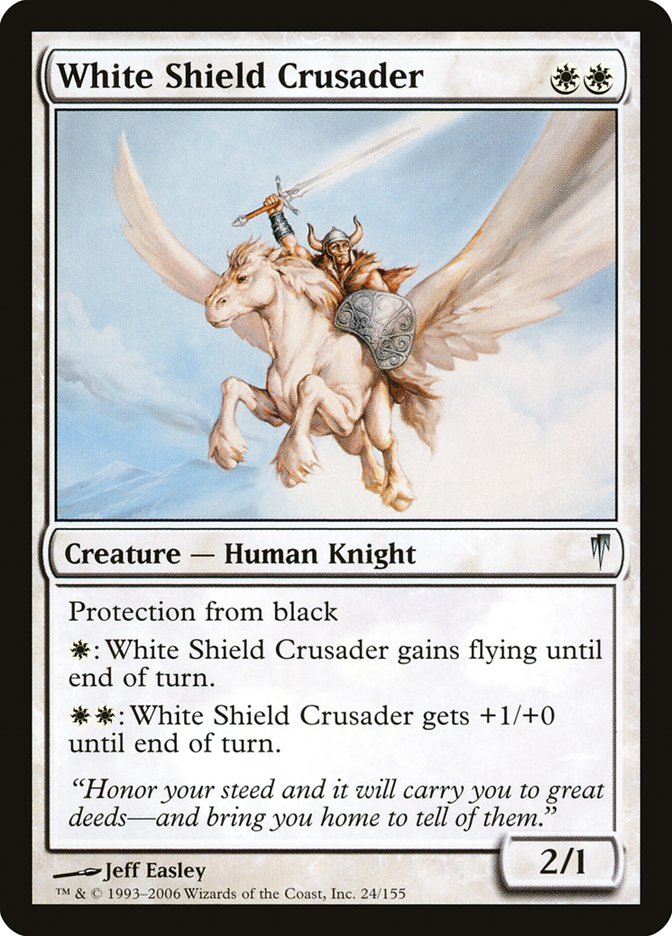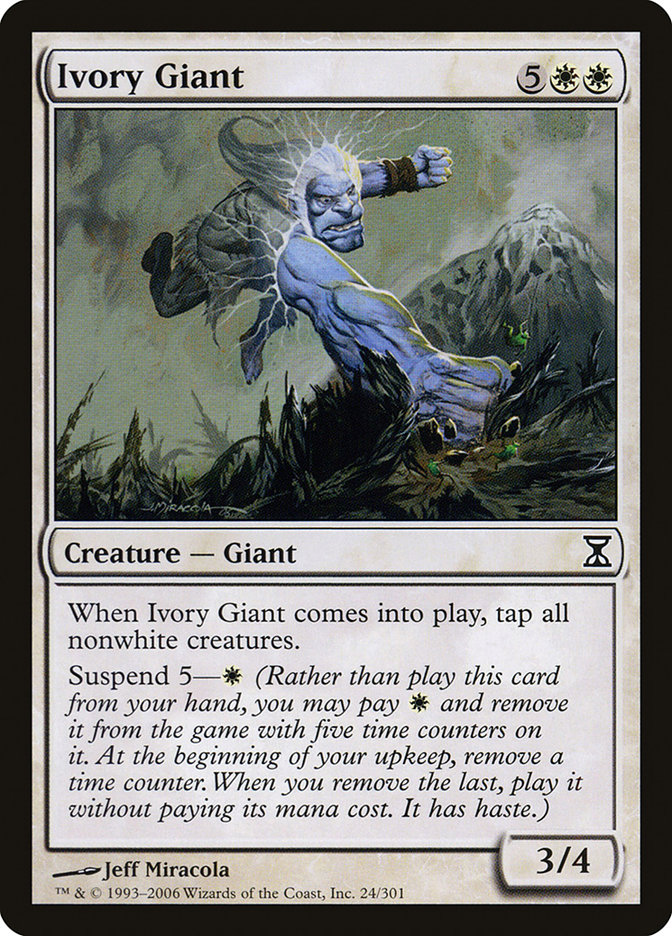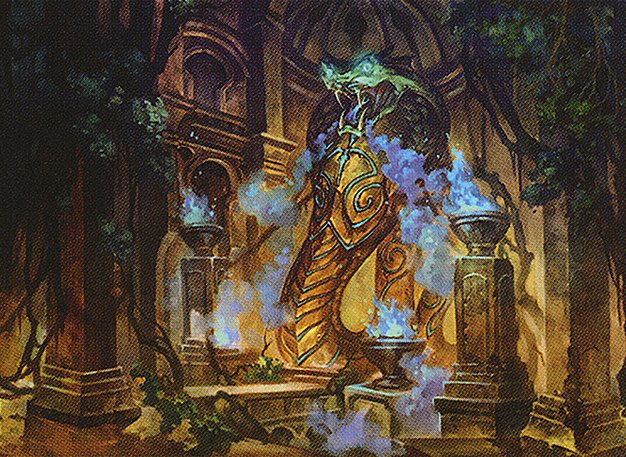Riftmarked Knight MTG Card
| Card sets | Released in 2 setsSee all |
| Mana cost | |
| Converted mana cost | 3 |
| Rarity | Uncommon |
| Type | Creature — Human Rebel Knight |
| Abilities | Flanking,Protection,Suspend |
| Power | 2 |
| Toughness | 2 |
Key Takeaways
- Generates two Knight tokens, offering a significant increase in battlefield presence with a single card.
- Flanking ability adds a combat edge, surprising opponents with an instant boost to your forces.
- Protection from black provides a strategic advantage, making it a formidable presence in diverse decks.
Text of card
Flanking, protection from black Suspend 3— When the last time counter is removed from Riftmarked Knight while it's removed from the game, put a 2/2 black Knight creature token with flanking, protection from white, and haste into play.
Card Pros
Card Advantage: Riftmarked Knight is equipped with the ability to create two Knight tokens under specific conditions, effectively offering players a 3-for-1 deal on creatures. This can significantly bolster your presence on the battlefield and give you an edge in creature quantity.
Resource Acceleration: Although Riftmarked Knight doesn’t directly accelerate resources in terms of mana, the generated tokens can be a boon for strategies that benefit from having multiple creatures. This can be particularly useful in decks that utilize creature-based synergies or sacrifice mechanics, indirectly boosting your resources.
Instant Speed: While the Knight itself isn’t an instant, its flanking ability can be a surprise element during combat. Plus, if you cast it during your main phase, you’ll immediately gain a 2/2 white Knight creature token with flanking, ready to either bolster your defenses or apply pressure on your next turn.
Card Cons
Discard Requirement: One downside of the Riftmarked Knight is the necessity to discard another card when harnessing specific abilities. This can be particularly limiting during the late game when every card in hand counts towards your strategy.
Specific Mana Cost: The Riftmarked Knight requires a precise mana configuration of one white and two other mana to cast. This specific cost can be restrictive and challenging to meet in decks that run multiple colors or require a flexible mana base.
Comparatively High Mana Cost: With a casting cost that sits at three mana total, the Riftmarked Knight might not be the most mana-efficient option for some strategies. Considering the pace of the current meta, players may find that other cards provide similar benefits for less mana or offer more impactful effects for the same cost.
Reasons to Include Riftmarked Knight in Your Collection
Versatility: Riftmarked Knight offers flexibility with its split-second ability, allowing you to smoothly adapt to various game situations. Its protection from black grants it resilience on the battlefield, making it a reliable choice for decks that face a lot of black-based removal.
Combo Potential: With the ability to produce Knight tokens with protection, this card can synergize well with strategies that capitalize on token generation or benefit from creatures that can evade common removal. This opens up avenues for combo plays in Knight-themed or token-centric decks.
Meta-Relevance: Considering the frequent presence of black in competitive formats, including Riftmarked Knight in your arsenal ensures that you have a creature capable of withstanding popular removal spells. Its adaptability can make it a solid choice against a variety of decks, keeping your strategy effective in the evolving meta.
How to Beat Riftmarked Knight
Riftmarked Knight adds a twist to the gameplay with its unique ability suite. This white card features the flanking ability, challenging opponents to think twice before blocking. In addition to that, when Riftmarked Knight is removed from the game, it leaves behind a black Knight token with protection from white, which returns as a formidable adversary later on.
Combatting Riftmarked Knight requires a strategic approach. The key is to mitigate its effect without triggering its departure ability. Using cards that reduce its power and toughness could be effective, as it doesn’t have an inherent resistance to shrinking effects. Moreover, bypassing combat through direct removal spells that don’t send it out of the game can be a way to deal with both the knight and the potential token. Cards like Path to Exile can exile it directly without the downside of its leave the game ability triggering.
Tackling Riftmarked Knight is about foresight and control. Employing tactics that subvert its abilities or remove it from play with precise timing can turn the tide of battle in your favor, demonstrating the importance of understanding and planning for each piece’s role on the sprawling chessboard that is a game of Magic: The Gathering.
Cards like Riftmarked Knight
Riftmarked Knight stands out among split second cards in Magic: The Gathering. It’s akin to other knights like White Shield Crusader, sharing the same creature type and a proclivity for protection from specific colors. However, Riftmarked Knight brings versatility with its suspend ability, akin to Ivory Giant, which also taps opposing creatures when it comes off suspend. This duality, allowing you to access effects at different times separates Riftmarked Knight from traditional knight cards that offer static abilities.
Within this sphere, we also find Benalish Cavalry, which shares the flanking ability that Riftmarked Knight boasts. However, Benalish Cavalry lacks the suspended play option, rendering it less adaptable to varying game states. Flanking, though, is where these cards meet, making them both valuable for combat-centric strategies.
Ultimately, Riftmarked Knight occupies a unique niche, offering the flanking ability while also creating added strategic turns via suspending and phased-in tokens. It’s this combination that gives it an edge during gameplay, balancing immediate board presence with future threat potential.
Where to buy
If you're looking to purchase Riftmarked Knight MTG card by a specific set like Planar Chaos and Time Spiral Remastered, there are several reliable options to consider. One of the primary sources is your local game store, where you can often find booster packs, individual cards, and preconstructed decks from current and some past sets. They often offer the added benefit of a community where you can trade with other players.
For a broader inventory, particularly of older sets, online marketplaces like TCGPlayer, Card Kingdom and Card Market offer extensive selections and allow you to search for cards from specific sets. Larger e-commerce platforms like eBay and Amazon also have listings from various sellers, which can be a good place to look for sealed product and rare finds.
Additionally, Magic’s official site often has a store locator and retailer lists for finding Wizards of the Coast licensed products. Remember to check for authenticity and the condition of the cards when purchasing, especially from individual sellers on larger marketplaces.
Below is a list of some store websites where you can buy the Riftmarked Knight and other MTG cards:
- eBay
- TCG Player
- Card Kingdom
- Card Market
- Star City Games
- CoolStuffInc
- MTG Mint Card
- Hareruya
- Troll and Toad
- ABU Games
- Card Hoarder Magic Online
- MTGO Traders Magic Online
See MTG Products
Printings
The Riftmarked Knight Magic the Gathering card was released in 2 different sets between 2007-02-02 and 2021-03-19. Illustrated by William O'Connor.
| # | Released | Name | Code | Symbol | Number | Frame | Layout | Border | Artist |
|---|---|---|---|---|---|---|---|---|---|
| 1 | 2007-02-02 | Planar Chaos | PLC | 14 | 2003 | Normal | Black | William O'Connor | |
| 2 | 2021-03-19 | Time Spiral Remastered | TSR | 38 | 2015 | Normal | Black | William O'Connor |
Legalities
Magic the Gathering formats where Riftmarked Knight has restrictions
| Format | Legality |
|---|---|
| Commander | Legal |
| Legacy | Legal |
| Paupercommander | Restricted |
| Modern | Legal |
| Oathbreaker | Legal |
| Vintage | Legal |
| Duel | Legal |
| Predh | Legal |
Rules and information
The reference guide for Magic: The Gathering Riftmarked Knight card rulings provides official rulings, any errata issued, as well as a record of all the functional modifications that have occurred.
| Date | Text |
|---|---|
| 2021-06-18 | A creature cast using suspend will enter the battlefield with haste. It will have haste until another player gains control of it. (In some rare cases, another player may gain control of the creature spell itself. If this happens, the creature won’t enter the battlefield with haste.) |
| 2021-06-18 | As the second triggered ability resolves, you must cast the card if able. You must do so even if it requires targets and the only legal targets are ones that you really don’t want to target. Timing permissions based on the card’s type are ignored. |
| 2021-06-18 | Cards exiled with suspend are exiled face up. |
| 2021-06-18 | Exiling a card with suspend isn’t casting that card. This action doesn’t use the stack and can’t be responded to. |
| 2021-06-18 | If an effect refers to a “suspended card,” that means a card that (1) has suspend, (2) is in exile, and (3) has one or more time counters on it. |
| 2021-06-18 | If the card has in its mana cost, you must choose 0 as the value of X when casting it without paying its mana cost. |
| 2021-06-18 | If the first triggered ability of suspend (the one that removes time counters) is countered, no time counter is removed. The ability will trigger again at the beginning of the card’s owner’s next upkeep. |
| 2021-06-18 | If the second triggered ability is countered, the card can’t be cast. It remains exiled with no time counters on it, and it’s no longer suspended. |
| 2021-06-18 | If the spell requires any targets, those targets are chosen when the spell is finally cast, not when it’s exiled. |
| 2021-06-18 | If this is suspended, then when the last time counter is removed from it, both its triggered ability and the “cast this spell” part of the suspend ability will trigger. They can be put on the stack in either order. |
| 2021-06-18 | If you can’t cast the card, perhaps because there are no legal targets available, it remains exiled with no time counters on it, and it’s no longer suspended. |
| 2021-06-18 | If you cast a card “without paying its mana cost,” such as with suspend, you can’t choose to cast it for any alternative costs. You can, however, pay additional costs. If the card has any mandatory additional costs, you must pay those if you want to cast the card. |
| 2021-06-18 | Suspend is a keyword that represents three abilities. The first is a static ability that allows you to exile the card from your hand with the specified number of time counters (the number before the dash) on it by paying its suspend cost (listed after the dash). The second is a triggered ability that removes a time counter from the suspended card at the beginning of each of your upkeeps. The third is a triggered ability that causes you to cast the card when the last time counter is removed. If you cast a creature spell this way, it gains haste until you lose control of that creature (or, in rare cases, you lose control of the creature spell while it’s on the stack). |
| 2021-06-18 | The mana value of a spell cast without paying its mana cost is determined by its mana cost, even though that cost wasn’t paid. |
| 2021-06-18 | When the last time counter is removed, the second triggered ability of suspend (the one that lets you cast the card) triggers. It doesn’t matter why the last time counter was removed or what effect removed it. |
| 2021-06-18 | You are never forced to activate mana abilities to pay costs, so if there is a mandatory additional mana cost (such as from Thalia, Guardian of Thraben), you can decline to activate mana abilities to pay for it and hence fail to cast the suspended card, leaving it in exile. |
| 2021-06-18 | You can exile a card in your hand using suspend any time you could cast that card. Consider its card type, any effects that modify when you could cast it (such as flash) and any other effects that stop you from casting it (such as from Meddling Mage’s ability) to determine if and when you can do this. Whether you could actually complete all steps in casting the card is irrelevant. For example, you can exile a card with suspend that has no mana cost or that requires a target even if no legal targets are available at that time. |













